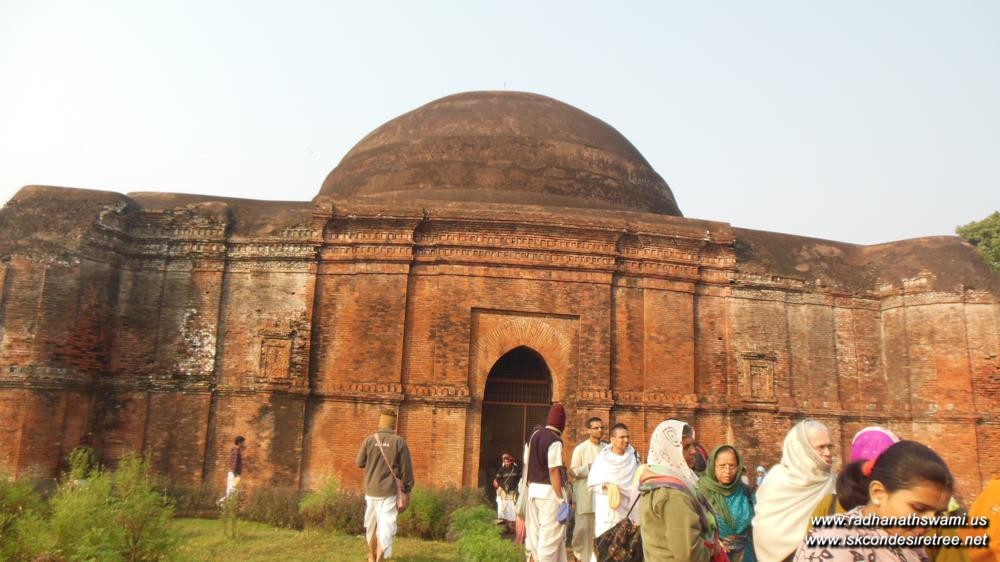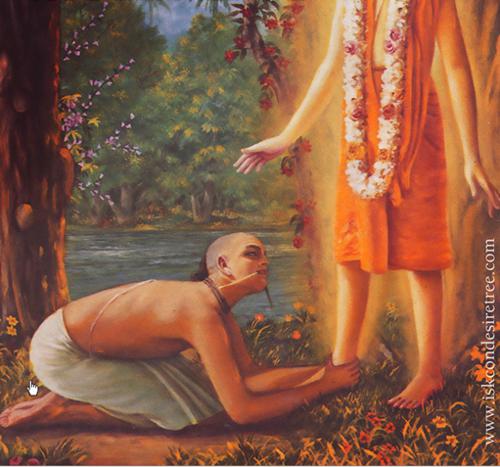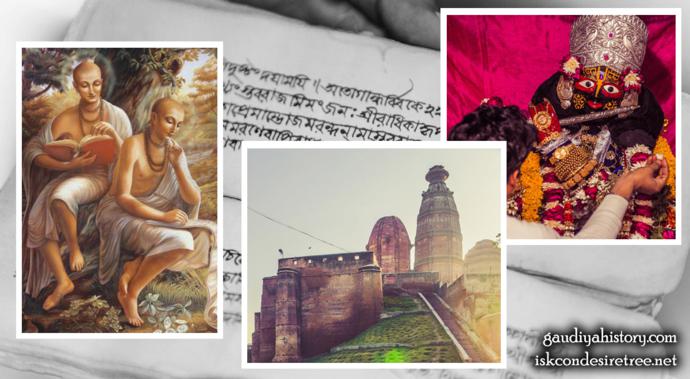
In 1517, Shri Rupa Goswami and Shri Sanatana Goswami, his elder brother, came to Vrindavana to fulfill four orders of Lord Chaitanya's: (1) Uncover Shri Krishna's lost pastime places. (2) Install Deities, start puja. (3) Write bhakti-shastras. (4) Propagate the rules of bhakti-yoga. (In the wallpaper: Rupa amd Sanatana Goswamis, Lord Shri Gopintha in Jaipur and Temple of Madan Mohan, Shri Vrindavan Dham).
In 1517, Shri Rupa Goswami and Shri Sanatana Goswami, his elder brother, came to Vrindavana to fulfill four orders of Lord Chaitanya's:
(1) Uncover Shri Krishna's lost pastime places.
(2) Install Deities, start puja.
(3) Write bhakti-shastras.
(4) Propagate the rules of bhakti-yoga.
Wearing only kaupina (loincloth) and kantha (patchwork quilt), Shri Rupa Goswami lived a mendicant's life absorbed in hearing, chanting, writing about Radha-Govinda's sweet loving pastimes in Shri Vrindavana-dhama. More details of his conduct and character are mentioned in Sanatana Goswami's biography.
Shri Rupa Goswami wrote practical yet profound transcendental books. He established Shri-Shri Radha-Govindaji, the beloved Deities of the entire Gaudiya sampradaya. Through extensive Vedic research Shri Rupa Goswami proved that Shri Chaitanya's teachings present the highest philosophy and the perfection of religion.
Gaudiya Vaishnavas are known as rupanugas, followers of Shri Rupa Goswami. Every raganuga Devotee aspires to become a servant of the servant of the lotus feet of Shri Rupa Goswami. Shri Narottama Dasa Thakura sings, shri-rupa-manjari-pada, se more sampada, sei mor bhajana pujana: "The feet of Shri Rupa-manjari (Rupa Goswami's eternal form as Shri Radha's maidservant in Vraja) are my only wealth. They are the only object of my service and worship."
Shri Chaitanya Mahaprabhu commissioned Shri Rupa Goswami to write on the science of rasa-tattva. In Chaitanya-chandrodaya, Shri Kavi Karnapura says that Shri Rupa Goswami is the form of true love and devotion. Shri Chaitanya empowered him to explain His own love and devotion, and to propagate it to the world. Lord Chaitanya manifested His own pastimes through Shri Rupa Goswami. He received the title bhakti-rasacharya (guru of devotional mellows) for his devotional classics, Bhakti-rasamrta sindhu, Ujjvala Nilamani, Lalita Madhava and others. Bhakti-rasamrta sindhu gives the essence of all Vedic scriptures regarding the kingdom of bhakti. In great detail it explains how to advance in Krishna consciousness and attain prema-bhakti, pure unalloyed love for Radha-Govinda in Shri Vrindavana.
To understand the loving affairs of Radha and Krishna, says Narottama Dasa Thakura, you must serve the lotus feet of Shri Rupa Goswami with intense eagerness. Serving means hearing (studying), chanting and strictly following the teachings of Shri Rupa Goswami. Serving also means praying to, crying out to, meditating upon, and dedicating your entire life to the lotus feet of Shri Rupa Goswami (Shri Rupa-manjari). Sadhana Dipika states that those on the path of devotional service must always associate with Shri Rupa Goswami's doctrines on prema-bhakti. By the grace of Shri Jiva Goswami one can understand the transcendental truths of Rupa Goswami's teachings.
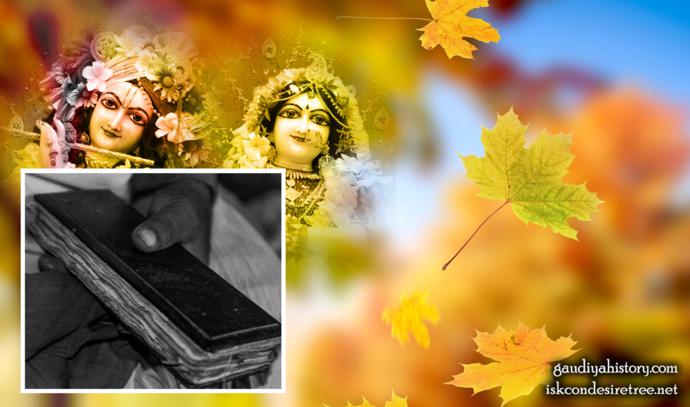
"When Shri Rupa Goswami would sit in his bhajana kutir at Ter Kadamba (Nandagram, Vrindavana), and write about the pangs of separation that Shri Radha and Shri Krishna felt for one another the leaves of the Kadamba tree would fall off; just like tears running down the face of someone in pain. And when Shri Rupa wrote about Radha and Krishna's ecstatic loving reunion, that overjoyed Kadamba tree immeditately sprouted new leaves and blossoming flowers. By the mercy of a pure Vaishnava like Shrila Rupa Goswami this Kadamba tree could understand and appreciate the intimate and confidential subject matters which remain beyond our comprehension." (In the wallpaper: Shri Shri Radha Gopinath, a book and falling leaves).
The following quote shows the incredible potency of Shri Rupa Goswami's transcendental writing:
"When Shri Rupa Goswami would sit in his bhajana kutir at Ter Kadamba (Nandagram, Vrindavana), and write about the pangs of separation that Shri Radha and Shri Krishna felt for one another the leaves of the Kadamba tree would fall off; just like tears running down the face of someone in pain. And when Shri Rupa wrote about Radha and Krishna's ecstatic loving reunion, that overjoyed Kadamba tree immeditately sprouted new leaves and blossoming flowers. By the mercy of a pure Vaishnava like Shrila Rupa Goswami this Kadamba tree could understand and appreciate the intimate and confidential subject matters which remain beyond our comprehension." (Shripad B.V. Narayana Maharaja)
Shri Rupa Goswami established the Deities of Radha-Govinda in Vrindavana. Bhakti-ratnakar quotes one song from Shrinivasa Acharya to describe the beauty of Rupa Goswami's beloved Govindaji Deity: "Having seen the incomparable beauty of Shri Govinda, Shri Radhika begins describing it to Her sakhis: 'Who has sculptured that moon like face and who has sculptured those two lotus eyes? Only My heart knows how I feel when I see Him. Who has shaped His earrings, cut carefully in gems? My mind is fixed on them. His nose pearl surrounded by a golden ring looks like a moon-like white flower surrounded by lightning, smiling from behind some blue clouds.
'His forehead is decorated with sandal tilaka and beautiful mind-enchanting designs. He shines within My heart. Yet My heart aches being incapable of beholding His beautiful face to My full satisfaction. If God had given Me the power I could continually enjoy His sweet voice. His arms are stronger than the trunks of elephants. My youthful body longs for the touch of His fingers. His graceful movements rival the gait of a maddened elephant. He is an ocean of beauty.'"
Today in Jaipur, Rajasthan Shri Rupa Goswami's original Deities of Radha-Govindaji are forever expanding their unlimited beauty. Everyday ten-thousand Devotees run to attend Their mangala arotika. A prati-bhu Deity of Govindaji resides in "new" Govindaji Temple behind the historic masterpiece of architecture that once served Radha-Govinda in Vrindavana.
Shri Krishna Dasa Kaviraja says the Deity of Radha-Govindaji shows us how to worship Radha and Krishna. Radha-Govindaji accept our service and give inspiration to increase our surrender on the path of bhakti. Acting exactly like the shiksha-guru, Govindaji directs us and gives us opportunities to serve Him.
Some authorities claim that in 1564 Shri Rupa Goswami entered Radha-Govindaji's nitya-lila, just twenty-seven days after the disappearance of Shri Sanatana Goswami. Shri Rupa Goswami's samadhi and bhajana kutir are in Seva Kunja within the courtyard of the Radha-Damodara Temple.
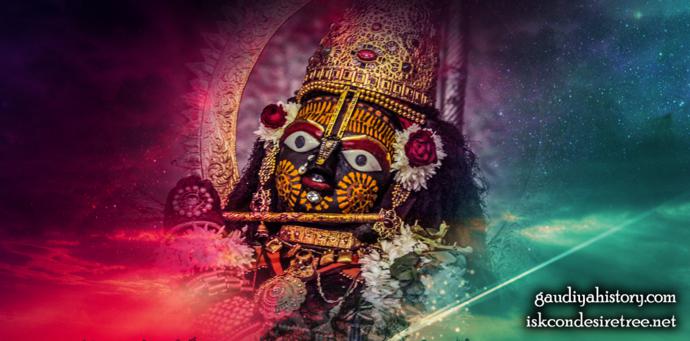
"Having seen the incomparable beauty of Shri Govinda, Shri Radhika begins describing it to Her sakhis: 'Who has sculptured that moon like face and who has sculptured those two lotus eyes? Only My heart knows how I feel when I see Him. Who has shaped His earrings, cut carefully in gems? My mind is fixed on them. His nose pearl surrounded by a golden ring looks like a moon-like white flower surrounded by lightning, smiling from behind some blue clouds. 'His forehead is decorated with sandal tilaka and beautiful mind-enchanting designs. He shines within My heart. Yet My heart aches being incapable of beholding His beautiful face to My full satisfaction. If God had given Me the power I could continually enjoy His sweet voice. His arms are stronger than the trunks of elephants. My youthful body longs for the touch of His fingers. His graceful movements rival the gait of a maddened elephant. He is an ocean of beauty.'" (In the wallpaper: Shri Govindaji, Jaipur).


